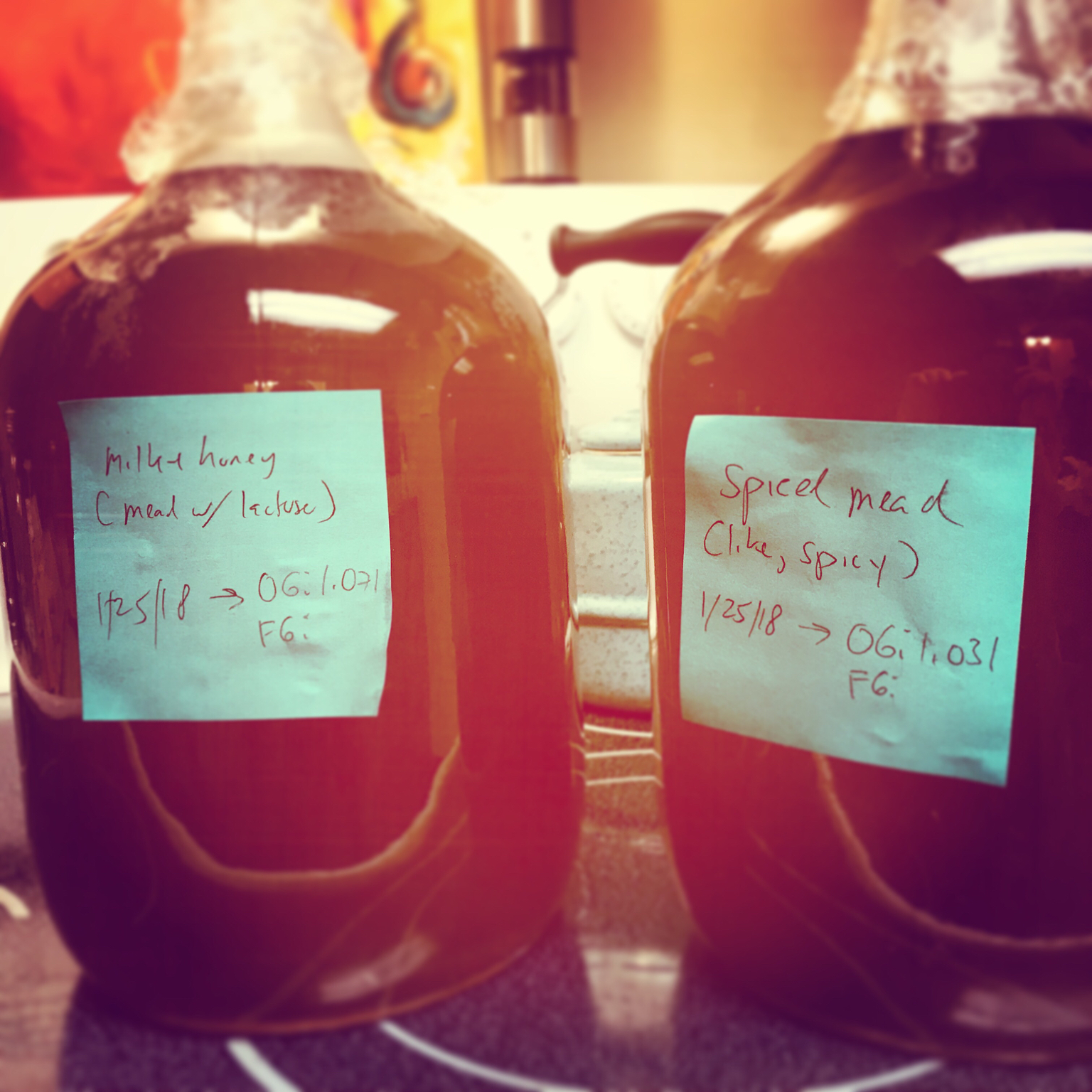thedevilandgod
Active Member
- Joined
- Dec 17, 2017
- Messages
- 42
- Reaction score
- 7
First, a little info. This is my first post in the mead forums. I’m a brewer by trade, but mead has been a fun hobby of mine over the past year or so. Reading over a lot of these posts have helped me solidify more of the lead making process, although I’m still quite a beginner for sure.
This weekend!
Check in on a hopped mead I made with another brewer a few weeks ago. While we both like mead, the hopped mead recipes I’ve found tend to use them as a dry hop, which doesn’t extract any alpha acids (bittering) of the hops, just aroma. We made a five gallon batch, boiling an ounce of hops to hit the middle ground of hop bitter and honey sweetness. The sample I pulled today is still pretty high in gravity (1.025), but it’s definitely starting to balance out a bit more.
Made two 1-gallon batches: a metheglin based of a dry mead recipe, and what I assume is a traditional sack mead recipe with lactose added. Again, a brewer, so my recipes might read funny, but I appreciate any feedback!
Angry Hornet (metheglin)
1.5 lbs. honey
1/2 tsp ground ginger
1/4 tsp cayenne powder
2 bags white tea
Boiled honey with three cups of water for 10 minutes to skim any wax/impurities. Remaining water (104 oz.) boiled, added tea and spices. Let cool to 85F, pitched rehydrated Côte Des Blances, and aerated. Added 1/2 tbsp of yeast nutrient. Fermenting at 75F.
Milk and Honey
3 lbs. honey
.25 lactose
Boiled honey with four cups water for ten minutes as the last recipe. Added lactose at end of boil to dissolve. Added to fermenter, then added pre-boiled water to top of fermenter. Same pitching as before.
These will be my four and fifth meads (although one was technically an acerglyn...). Looking forward to any feedback.
Cheers!

This weekend!
Check in on a hopped mead I made with another brewer a few weeks ago. While we both like mead, the hopped mead recipes I’ve found tend to use them as a dry hop, which doesn’t extract any alpha acids (bittering) of the hops, just aroma. We made a five gallon batch, boiling an ounce of hops to hit the middle ground of hop bitter and honey sweetness. The sample I pulled today is still pretty high in gravity (1.025), but it’s definitely starting to balance out a bit more.
Made two 1-gallon batches: a metheglin based of a dry mead recipe, and what I assume is a traditional sack mead recipe with lactose added. Again, a brewer, so my recipes might read funny, but I appreciate any feedback!
Angry Hornet (metheglin)
1.5 lbs. honey
1/2 tsp ground ginger
1/4 tsp cayenne powder
2 bags white tea
Boiled honey with three cups of water for 10 minutes to skim any wax/impurities. Remaining water (104 oz.) boiled, added tea and spices. Let cool to 85F, pitched rehydrated Côte Des Blances, and aerated. Added 1/2 tbsp of yeast nutrient. Fermenting at 75F.
Milk and Honey
3 lbs. honey
.25 lactose
Boiled honey with four cups water for ten minutes as the last recipe. Added lactose at end of boil to dissolve. Added to fermenter, then added pre-boiled water to top of fermenter. Same pitching as before.
These will be my four and fifth meads (although one was technically an acerglyn...). Looking forward to any feedback.
Cheers!









![Craft A Brew - Safale S-04 Dry Yeast - Fermentis - English Ale Dry Yeast - For English and American Ales and Hard Apple Ciders - Ingredients for Home Brewing - Beer Making Supplies - [1 Pack]](https://m.media-amazon.com/images/I/41fVGNh6JfL._SL500_.jpg)


















































